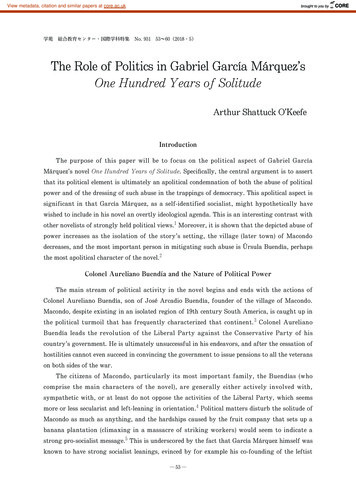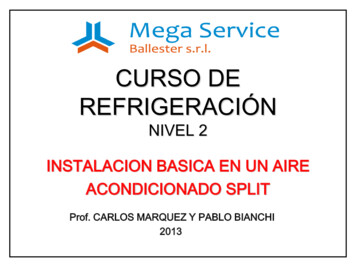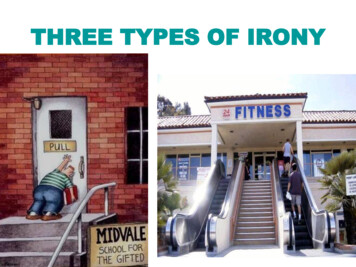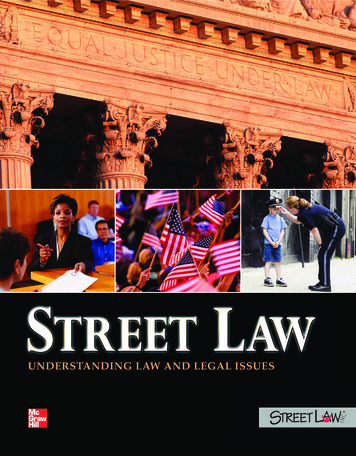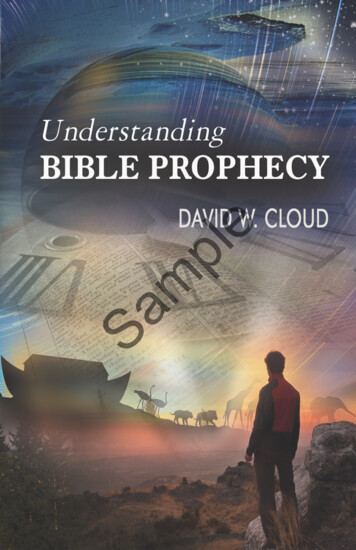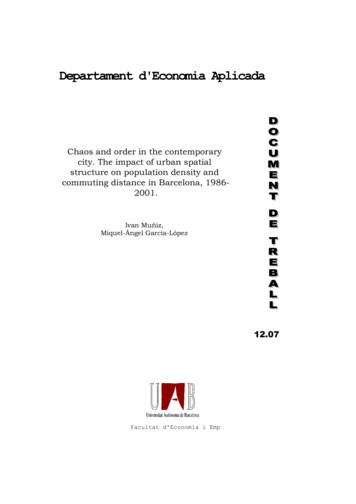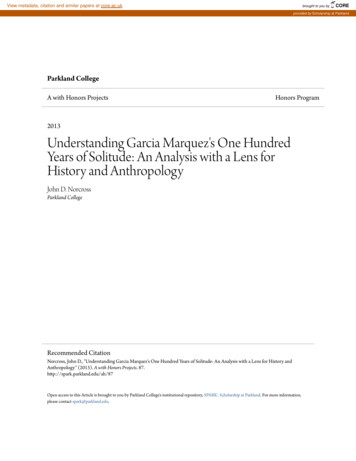
Transcription
View metadata, citation and similar papers at core.ac.ukbrought to you byCOREprovided by Scholarship at ParklandParkland CollegeA with Honors ProjectsHonors Program2013Understanding Garcia Marquez's One HundredYears of Solitude: An Analysis with a Lens forHistory and AnthropologyJohn D. NorcrossParkland CollegeRecommended CitationNorcross, John D., "Understanding Garcia Marquez's One Hundred Years of Solitude: An Analysis with a Lens for History andAnthropology" (2013). A with Honors Projects. 87.http://spark.parkland.edu/ah/87Open access to this Article is brought to you by Parkland College's institutional repository, SPARK: Scholarship at Parkland. For more information,please contact spark@parkland.edu.
Understanding Garcia Marquez’s One Hundred Years of Solitude:An Analysis with a Lens for History and Anthropologyby Jack Norcross
One Hundred Years of Solitude:Gabriel Garcia Marquez’s One Hundred Years of Solitude is a workof fiction. The Buendías—the family whose history it chronicles—are anelaborate imagination. Macondo—the utopic town, which serves as thebackdrop—is, in reality, nothing more than the name of a fruit company inAracataca, Colombia. The geographical location—fourteen months ofhiking westward from Riohuaca, next to a river, amongst thick forest, on thewestern slope of a mountain—can be found on a map of Colombia, but thereis no town that both exists there and directly follows the happenings andhistory of Garcia Marquez’s Macondo. The only undiluted history in OneHundred Years of Solitude comes in its references to distant colonial figuresand more contemporary authors.1One Hundred Years of Solitude is a work of fiction, but thehappenings of this novel directly parallel the regional history of theCaribbean coast of Colombia along with its interactions with Bogotá (thecapitol of Colombia) and the surrounding nation. In an area of the worldwhere any post-colonial history is remarkably fluid and an accurate precolonial history is almost non-existent, Garcia Marquez’s account ofhistorical happenings within the realm of fiction is remarkablysignificant.2 In post-colonial Colombia, there is precedence for this sort1’Undiluted’ here means: ‘uninfluenced by the fictional surroundings.’In any anthropological analysis/discussion, it is important for theanthropologist/opinion-maker to practice reflexivity. Of course, reflexivity inthe sense of literary analysis doesn’t capture the fullness of reflexivity in thefield. I do not have to be concerned how my history and bias will influence thesubject of my analysis, as this subject has been written for decades before I wasborn. I do have to be critical of how my unique position in life might influencehow I perceive the text and what data I find significant. Therefor—whileannouncing the significance of Garcia Marquez’s history, it feels appropriatefor me to mention the ways in which my life and political views may be moresympathetic to the Liberal cause and Garcia Marquez’s own Liberal leanings.I am a young man who lives in radical communities that serve themarginalized and homeless in our country. I already have a propensity forrelatively extreme liberal leanings (relative to the center) and a general distrustof those in power. Add to this that I was raised in a religious family, which Irebelled against, and you will find that I am very much predisposed to besympathetic to Garcia Marquez’s Liberal sympathies. Conservatives in thisnovel represent the big government, militaristic, semi-tyrannical protectors ofthe Catholic faith. None of these things are things I’m on board with.2of historical manipulpolitical parties attemcampaigns of misinfopublished in variousnovel that quietly tellcanonized a record thaccounts of history.4Garcia Marqthe first eight years o3In her book, MuddiColombia: 1846-1948,and importance of thisColombia was largelyparty had a specific intthrough manipulationhistories were writtenroom for much manipujustify the process of ‘clearly racist ideologyindigenous populationdifficult to decipher.While deferring a fcompeting histories munderstanding these hicultural values of ColoCauca coffee region. Ttells the likely mytholofounding date of Auguindependence). Appelactually founded on thfounded by the mergerencapsulated the perfetwo settlements. AppeLiberal publication—Lhas since pervaded theAppelbaum asserts thabetter understand the thistory can (and does)values and aspirations.independence.)4I was reluctant to uanthropologists are rigtypically the histories wculture of a subjugatedthis is a bit different. S
s of Solitude is a workchronicles—are anhich serves as theof a fruit company inurteen months ofgst thick forest, on theof Colombia, but therehe happenings andluted history in Oneistant colonial figuresction, but thehistory of thens with Bogotá (then area of the worldd an accurate prez’s account ofmarkablydence for this sortrroundings.’ant for thecourse, reflexivity inof reflexivity in thebias will influence thedecades before I wasn life might influenceherefor—whileit feels appropriateviews may be morewn Liberal leanings.t serve thea propensity forand a general distrustous family, which Iedisposed to benservatives in thisannical protectors ofboard with.of historical manipulation3. Throughout decades of internal strife,political parties attempted to shape the prevailing history throughcampaigns of misinformation, biased reporting, and exaggerationspublished in various Conservative and Liberal newspapers. By writing anovel that quietly tells a history of Colombia, Garcia Marquez hascanonized a record that is largely sympathetic to Liberal ideology andaccounts of history.4Garcia Marquez’s Macondo is inspired by the city where he spentthe first eight years of his life, Aracataca. In Aracataca, Garcia Marquez3In her book, Muddied Waters: Race, Region, and Local History inColombia: 1846-1948, Nancy P. Appelbaum discusses some of the reasons forand importance of this remarkably fluid history. Since power in post-colonialColombia was largely contested, written records were often destroyed. Eachparty had a specific interest in containing and shaping the public dialoguethrough manipulation of news media. Because of this, several competinghistories were written and destroyed and written again. This fluid history gaveroom for much manipulation. In attempting to define a racial hierarchy andjustify the process of ‘whitening’ the population, many histories adoptedclearly racist ideology in attempting to define the pre-Columbian history ofindigenous populations. In the noise, most indigenous histories becamedifficult to decipher.While deferring a factually accurate chronology of occurrences from thesecompeting histories may be nearly impossible, Appelbaum maintains thatunderstanding these histories is of importance when trying to understand thecultural values of Colombian societies. She focuses on Riosucio, a city in theCauca coffee region. To stress the importance of artificial local histories, shetells the likely mythological Riosucio origin story. She focuses on the believedfounding date of August 7th, 1819 (The day of a famous battle in the war forindependence). Appelbaum contends that it is unlikely that Riosucio wasactually founded on this day. Even more unlikely was the Riosucio wasfounded by the merger between two villages and has, since its founding,encapsulated the perfect harmony between the different races (razas) of thesetwo settlements. Appelbaum suspects that the first mention of this story, in theLiberal publication—La Opinion, was actually the fabrication of this story. Ithas since pervaded the culture to the point that it is now acceptable fact.Appelbaum asserts that, by understanding this story and its origin, we canbetter understand the thoughts and dreams of the Colombian people. A fluidhistory can (and does) serve as a canvas for the people to share their culturalvalues and aspirations. (In this case: Riosucio was born of harmony inindependence.)4I was reluctant to use the word ‘canonized’ here, recognizing that modernanthropologists are rightfully suspicious of any canonical history, as these aretypically the histories written by imperial oppressors at the expense of theculture of a subjugated population. In the case of Colombian history, however,this is a bit different. See above footnote.
lived with his maternal grandparents. His grandfather, Colonel NicolásRicardo Márquez Mejía, was a retired Liberal general who had foughtduring Colombia’s One-thousand Day War. His grandmother, DoñaTranquilina Iguarán, told stories which share the fluidity between themythical and the real that would later become the basis for his greatestcontribution to literature, a style used in One Hundred Years of Solitude,Magic Realism. The origin story of Macondo, aside from the utopic idealsnecessary to create a world in which mythology is believable, is largelyreflective of the geographic history of the land in Colombia that is justinland of the Caribbean coast.Towns settled throughout much of Colombia remained largelyautonomous for decades after the rest of Latin America was quickly beingconnected by large-scale infrastructure. This is partially because of thedifficulty of navigating the terrain. Colombian geography is a mix ofmountains, swamps, and thick forests with only a small portion of the landthat is relatively flat and easier to traverse.5 Aracataca is settled in a thickforest, just west of the Sierra Nevada de Santa Marta and east of swampland5Any analysis of Colombian history, including this analysis of historicallysignificant context in One Hundred Years of Solitude, would beanthropologically insignificant without acknowledging the impact ofColombian geography on the formation of regions and development of aracially heated dialogue within the context of these regions. In MuddiedWaters, Appelbaum discusses the manner in which the difficult to traverseterrain in Columbia and the extreme variety of climates gave rise to relativelyinsular communities. In early attempts to make sense of these communities,many anthropologists and sociologists would attribute what may have beenenvironmentally created/sustained traits to differences in race. For example, inthe Andean highlands, an industrious white and mestizo population builtprosperous communities. Meanwhile, miles down the mountain, in the tropicallowlands, darker skinned indigenous peoples were content to live off the land(as agriculture was less of a possibility and the land did provide sufficientsustenance). Here you can see how geographic differences influencedculturally different regions. In turn, these regional differences were associatedwith race and used to justify a racially charged dialogue that glorified the hardworking, white ethos over the slothenly indigenous.Obviously, this geographic separation also influenced regional politicaldifferences and the overall propensity for civil war within Colombia. As large,geographically autonomous cities emerged, they formed strong polities thatoperated almost as republics. Many times, towns and cities in an immediategeographical region felt more responsible to their neighbors than they did totheir country. It is easy to see how, given this dynamic, any variety of opinionor competing discourse could (and did) propel the nation into civil war.that extends out towageography. Historicaarrive at the party ofMacondo also sharesMacondo’s fgroup of travelling gtravellers, the Caribbin stark contrast to thColombia experiencesettled, the Caribbeancultures of the worldcontact with travelerevolved very much sutopia, this contact wcolonial influence. IBuendía, actively soureality, much of the mwelcome outside infloutsiders’ did eventucomplete destructionBuendía’s curiosity athe town toward furthMany historiworld economy to itsthe responsibility ofeconomy, Colombiawithout investing inof the gold’s locationMinimal infrastructufrom the path to the rtaming the rough terrlonger sufficient to sinfrastructure to tranBy this time, the cap
Colonel Nicoláswho had foughtmother, Doñaty between thes for his greatestYears of Solitude,om the utopic idealsevable, is largelymbia that is justemained largelya was quickly beingly because of thephy is a mix ofl portion of the landis settled in a thicknd east of swamplandysis of historicallyuld beimpact ofvelopment of as. In Muddiedficult to traverseve rise to relativelyhese communities,at may have beenace. For example, inopulation builtuntain, in the tropicalto live off the landovide sufficients influencednces were associatedat glorified the hard-egional politicalColombia. As large,rong polities thats in an immediaters than they did tony variety of opinionnto civil war.that extends out towards the coast. Garcia Marquez’s Macondo shares thisgeography. Historically, towns in this region were slow growing and late toarrive at the party of Colombian national politics. It is no surprise thatMacondo also shares the fate of real settlements in this area.Macondo’s first interaction with the outside world comes from agroup of travelling gypsies. Because of its accessibility to seafaringtravellers, the Caribbean coast of Colombia evolved in a manner that standsin stark contrast to the rest of Colombia. While many of the regions ofColombia experienced decades of relatively insular growth after beingsettled, the Caribbean coast was immediately exposed to the peoples andcultures of the world. Garcia Marquez’s choice to have Macondo’s firstcontact with travelers from far away is an important tribute to a region thatevolved very much separate of the capitol. Of course, in Garcia Marquez’sutopia, this contact was representative of the inevitability of damagingcolonial influence. It seems important that his first protagonist, JoseBuendía, actively sought the knowledge and influence of the gypsies. Inreality, much of the mestizo population of Colombia did desire andwelcome outside influence. While Garcia Marquez’s ‘influence ofoutsiders’ did eventually lead to Macondo’s fall from glory (ending with itscomplete destruction), it is important to note that initial contact drove JoseBuendía’s curiosity and resulted in a wellspring of ideas that would drivethe town toward further prosperity.Many historians attribute Colombia’s difficulty competing in theworld economy to its technological backwardness. This is only partiallythe responsibility of its geography. Early in its exposure to the worldeconomy, Colombia allowed most of its gold to be mined and exportedwithout investing in advances in infrastructure. This was possible becauseof the gold’s location in the mountains to the west of the Magdalena River.Minimal infrastructure was necessary to transport gold to the river. Asidefrom the path to the river and the path to the capitol, there was not value intaming the rough terrain. Unfortunately, when the gold reserves were nolonger sufficient to sustain the stagnate Colombian economy, theinfrastructure to transport any commercially viable crop was not in place.By this time, the capitol lacked the resources and the know-how to
successfully build the roads and railroads necessary to provide low costtransport of freight. Colombian commodities could not be sold at a pricethat would compete in the world market. As of 1850, it cost roughly thesame to transport goods from the capitol in Bogotá to the port at the mouthof the Magdalena as it did to cross the Atlantic from England.Jose Buendía’s frustrated attempts to connect Macondo echo thefrustration of Colombia’s national economy. First, he wants to relocateMacondo to be on the sea. This would have worked as far as exposure goes.The towns on the Caribbean coast were able to grow and connect to theworld in ways in which the rest of Colombia was not. To be fair to GarciaMarquez, in this instance the fear of colonial influence is well founded.Coastal cities were quickly exploited, and slaves were shipped to the coastin abundance, in order to grow tropical crops.Later, Buendía has difficulty connecting the town to the road to thecapitol. The lack of interconnecting roads in rural Colombia had asignificant impact on the shape of national politics. Out of the distinctseparation between Bogotá and the rest of the nation, sparsely dotting thelandscape in the form of inaccessible villages, raised two competingpolitical ideologies which would serve as the primary platforms of warringparties for decades of civil unrest in Colombia including the three years atthe beginning of the twentieth century known as the One-thousand DayWar. While Jose Buendía was busy trying to connect Macondo to the restof Colombia, the capitol that he sought was establishing an elite enclave thatwould become the center of the Conservative politics. Underlying almostall the conflicts in post-independence Colombia was an ideological battlebetween those who wanted to centralize power in the capitol and those whowanted to federalize, thereby taking power from the capital and distributingit to autonomous states. Aside from brief periods during which both theConservatives and Liberals were pro-federalization, centralization primarilyfell to Conservatives, while Liberals perpetuated federalism in the ruralmunicipalities. These ideological encampments are similarly attributed inGarcia Marquez’s novel. Another similarity between Garcia Marquez’sLiberal and Conservative parties and the real Liberal and Conservativeparties is their religious affiliation. As in the history of Colombia, GarciaMarquez’s Conservacontrast, Liberals in Ctimes, Liberal leaderssignificantly restrict t6Anthropologists attrelativism. Cultural reshould be understood tcontrast to centuries ofdifferent cultures relatrelativism is functionaseek to understand in wwithin the society in wLatin America is anythCatholicism in Latin Aconflicts of Colombia.Since the advent ofestablishing and facilitcolonies. Used as a juquickly went about setof vastly different cultCatholic Church laid thgovern such a large spindependence, Catholiperpetuated its influenfurther promulgation oGarcia Marquez’s BChurch. Nevertheless,integration and expandconstruction of a chapeHowever, as the novelsource of subjugation.wife, Ursula) accept thIgnacio is demonstratewield the spiritual authWhat is even moreand the Conservative Amoral integrity of the cwhen the Conservativethe role of a clown-likfrom a party that claimseems to be insinuatinlack of respect given bCatholic authority, sugChurch as a means ofConservative regime.they believe it to be in
provide low costbe sold at a pricecost roughly thehe port at the mouthgland.Macondo echo thewants to relocatefar as exposure goes.d connect to theTo be fair to Garciais well founded.hipped to the coastwn to the road to theombia had at of the distinctparsely dotting thewo competinglatforms of warringg the three years ate-thousand DayMacondo to the restg an elite enclave thatUnderlying almostideological battleapitol and those whopital and distributingg which both thentralization primarilylism in the ruralmilarly attributed inGarcia Marquez’snd ConservativeColombia, GarciaMarquez’s Conservatives were closely aligned with the Catholic Church. Incontrast, Liberals in Colombia have, historically, been antichurch. Severaltimes, Liberal leaders exiled Jesuit orders from operating and sought tosignificantly restrict the power and influence of the church.66Anthropologists attempt to understand different cultures by practicing culturalrelativism. Cultural relativism is the idea that each culture’s practices and beliefsshould be understood through the specific lens of that own culture. This stands incontrast to centuries of ethnocentrism during which imperial societies defineddifferent cultures relative to their own. One perspective the sprung from culturalrelativism is functionalism. In studying the functional perspective, anthropologistsseek to understand in what ways institutions and practices serve a vital functionwithin the society in which they’re practiced. While the history of Catholicism inLatin America is anything but culturally relativistic, understanding the function ofCatholicism in Latin America is crucial to understanding the structures andconflicts of Colombia.Since the advent of Christianity, the church has served an important role inestablishing and facilitating hierarchical power structures in western society and itscolonies. Used as a justification for colonizing a continent of infidels, Catholicismquickly went about setting up the structure that would enable governing this worldof vastly different cultures. By converting (often forcibly) indigenous peoples, theCatholic Church laid the groundwork for the hierarchical structure necessary togovern such a large space (one god equals one law). After colonies had achievedindependence, Catholicism had been so firmly ingrained that new leadersperpetuated its influence by invoking religious legitimacy and encouraging thefurther promulgation of Christian ideologies.Garcia Marquez’s Buendías are, on the whole, suspicious of the CatholicChurch. Nevertheless, when Father Ignacio arrives in town the immediateintegration and expanding influence of the church is apparent. He is able to beginconstruction of a chapel, in the square, with the support of the townspeople.However, as the novel plays out, Garcia Marquez aptly identifies religion as asource of subjugation. While some people of Macondo (including Jose Buendía’swife, Ursula) accept the tenants of religion, overall skepticism wins out. FatherIgnacio is demonstrated as having declining influence over the town, unable towield the spiritual authority that he and the church sought.What is even more telling, perhaps, is the interaction between Father Ignacioand the Conservative Army. Conservatives purport to fight on the behalf of themoral integrity of the church and its importance as a national institution. However,when the Conservative Army arrives in Macondo, Father Ignacio is diminished tothe role of a clown-like fool. He is not offered the respect his office might expectfrom a party that claims to fight on behalf of the church. Here, Garcia Marquezseems to be insinuating that—functionally—religion has again been coopted. Thelack of respect given by the conservative army to Macondo’s representative ofCatholic authority, suggests that Conservatives are using support for the CatholicChurch as a means of perpetuating conflict and galvanizing support for theConservative regime. People may be likely to act contrary to their own interests ifthey believe it to be in service of an almighty god.
So, when Ursula finally does succeed in connecting Macondo witha town that is connected to the capitol and the capitol sends a representativeto perform as magistrate of this newly discovered settlement, JoseBuendía’s reaction is actually very telling. Buendía asserts himself and theautonomy of the town saying, “ we don’t need any judges here becausethere is nothing that needs judging.” He eventually allows the magistrate tostay on the conditions that the citizens retain their right to paint their houseswhatever color they would like and the soldiers must leave at once. Even ashe is allowing the magistrate to stay, Buendía makes certain the magistrateknows that they “are still enemies.”The conflict between Jose Buendía and the magistrate very muchencapsulates the conflict of Liberals and Conservatives. When Macondo isfinally connected to the outside world, they become subject to centralizedgovernment Conservatives who feel it is their right and duty to govern theoutlying provinces. Jose Buendía would almost certainly say that he is not apolitician. However, his actions are a perfect example of early Liberalprovincial leaders. He could not deny his charge. It seems to be a moralimperative. He had led these people to establish the settlement. He wasresponsible, in some way, to protect them from any perceived tyranny. Theconditions under which Jose Buendía allows the magistrate to stay arerepresentative of Liberal complaints with the Conservative regime. Themagistrate’s attempt to make the citizens of Macondo paint their housesblue in celebration of the anniversary of national independence is clearly anexample of the capitol drastically over reaching its purview. The armedguards sent to enforce the magistrate’s law are representative of a nationalarmy. To Conservatives, a national army was seen as crucial for protectingthe different territories of Colombia from outside invasion. Also, it wasseen as a necessary deterrent to local dissent. To Liberals, the army wasperceived as a puppet of politicians who sought to centralize that nationalgovernment at the expense of voices outside the capital. Recognizing theneed for some sort of military force, liberals opted to support theestablishment of local militias or even provincial armies, which may bemore likely to serve the people of their immediate area.Because of Ma position to be a revothe growth of the consdissent or the possibilthe capitol; they had,consequences. Howedemands of the magisconversion to an outpMacondo doeWhen Jose Buendía resecond son, Aurelianomagistrate’s youngestAureliano is spendingand talking politics. Wmagistrate is in chargimparts on AurelianoAt the same time, a libplanned rebellion. Wwitnesses the magistrareplace them with votconvince Aureliano totricky.” As the monthanger and ambition ofto join them in what hreaches the town thatoccupied by an armyAureliano changes hisWhen the soldMacondo’s, thus far, qwithout due process oby a rabid dog and bewhat it takes for Auregarrison. When Aureexecuted the general a
cting Macondo withends a representativement, Joseserts himself and thedges here becauseows the magistrate toto paint their housesave at once. Even asrtain the magistrategistrate very much. When Macondo isbject to centralizedduty to govern thely say that he is not aof early Liberalems to be a moralttlement. He wasceived tyranny. Thetrate to stay aretive regime. Thepaint their housesendence is clearly anview. The armedntative of a nationalrucial for protectingion. Also, it wasals, the army wasralize that national. Recognizing theupport thes, which may beBecause of Macondo’s isolation to this point, Jose Buendía is not ina position to be a revolutionary leader. As of yet, the town is not aware ofthe growth of the conservative hegemony. They are unaware of any liberaldissent or the possibility of an insurrection. They were interested in findingthe capitol; they had, and now they were learning how to live with theconsequences. However, Jose Buendía’s decision to make these twodemands of the magistrate did establish precedence for Macondo’s futureconversion to an outpost of Liberal resistance.Macondo does not emerge as a Liberal stronghold until years later.When Jose Buendía retreats to his solitude under the chestnut tree and hissecond son, Aureliano Buendía, is mourning the loss of his betrothed (themagistrate’s youngest daughter), things begin to unfold. At this time,Aureliano is spending his evenings with the magistrate, playing dominoesand talking politics. When the national election comes around and themagistrate is in charge of facilitating voting in Macondo, the magistrateimparts on Aureliano the importance of voting for the Conservative party.At the same time, a liberal group solicits Aureliano for his support in aplanned rebellion. When it comes time to count the votes, Aurelianowitnesses the magistrate throw out many votes for the Liberal candidate andreplace them with votes for the Conservative candidate. This is enough toconvince Aureliano to become a Liberal “ because the Conservatives aretricky.” As the months unfold and Aureliano becomes more aware of theanger and ambition of the Liberal strategizors in Macondo, he is unwillingto join them in what he considers a sort of bloodlust. It isn’t until wordreaches the town that war has began throughout the country and the town isoccupied by an army of Conservative soldiers sent from the capitol thatAureliano changes his mind.When the soldiers arrive, they execute the man who had organizedMacondo’s, thus far, quiet Liberal rebellion. They kill him in the streetwithout due process of law. Next, they seize a woman who has been bittenby a rabid dog and beat her to death with the butts of their rifles. This iswhat it takes for Aureliano to assemble the Liberal plotters and storm thegarrison. When Aureliano and his men had taken control of the town, theyexecuted the general and the four soldiers who had killed that woman. They
left Arcadio, Aureliano’s nephew, in charge of keeping order in the town.Aureliano took his new name, Coronel Aureliano Buendía, and his men andmarched to war. When Coronel Aureliano Buendía joins the armed conflictagainst the Conservative regime and leaves Arcadio in charge, heeffectively completes the town’s transition into a place of Liberal resistance.Macondo becomes strongly independent township, not lacking the courageto fight for itself. This is in keeping with many of the towns that wereinland of the Caribbean coast of Colombia.The circumstances that led Coronel Aureliano Buendía to take uparms are direct references to Colombian history. There are many accountsof tampering with votes. On top of that, Conservative armies were knownto use quasi-arbitrary violence to frighten the people into obedience. Bothof these patterns are widely credited for inciting many of the rural rebellionsagainst the Conservative regime. By choosing to represent this piece ofhistory, Garcia Marquez advances Colombia’s Liberal party in the battle forany moral high ground. In this account, Conservative violence can be easilyvillainized as semi-imperialistic.7 Because it is not integral to the story, thisselection of historical representation disregards the fact that some from theLiberal party had used similar tactics when they had taken power in thecapitol in the late 1840’s. Granted, Liberals had always drawn their powerfrom the peoples of
One Hundred Years of Solitude: Gabriel Garcia Marquez’s One Hundred Years of Solitude is a work of fiction. The Buendías—the family whose history it chronicles—are an elaborate imagination. Macondo—the utopic town, which serves as the backdrop—is, in reality, nothing more
